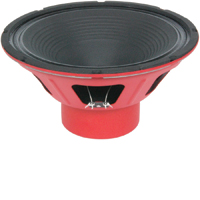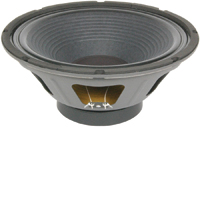 Who doesn’t know about Eminence speakers and wants to know more about this excellent brand of replacement speakers for guitar tone-junkies? Well then this interview will shed some light on any of your questions you may have. Anthony Lucas is the head of Technical Support and develops guitar speakers at Eminence Speakers located in Eminence, Kentucky. In this interview I asked Anthony some questions about Eminence speakers in their popular Legend, Patriot and Red Coat series. He also gives us some background history of Eminence speakers and talks a bit about the anatomy of a speaker and how it affects the end resulting tone from your amplifier.
Who doesn’t know about Eminence speakers and wants to know more about this excellent brand of replacement speakers for guitar tone-junkies? Well then this interview will shed some light on any of your questions you may have. Anthony Lucas is the head of Technical Support and develops guitar speakers at Eminence Speakers located in Eminence, Kentucky. In this interview I asked Anthony some questions about Eminence speakers in their popular Legend, Patriot and Red Coat series. He also gives us some background history of Eminence speakers and talks a bit about the anatomy of a speaker and how it affects the end resulting tone from your amplifier.
300guitars: Hi there Anthony. Can you please give us a little background about yourself and Eminence speakers?
Anthony Lucas: Hi Billy. Thanks for having me!
Eminence Speaker is a family owned business that was founded in 1966 by Bob Gault. You can learn more info on the startup of the company and basic information about our factory here: http://www.eminence.com/resources/resources.asp.
Our roots are in custom OEM manufacturing. We have produced thousands of unique, manufacturer specific designs over the years. In 1999, we started our own branded product line for distribution. While that continues to grow every year in sales and in the number of products we stock, we still are primarily an OEM supplier. A number of OEM customers have become accustomed to using our off-the-shelf products.
I grew up in Eminence, KY. It is a small, close-knit community of about 2500 people and abundant in Southern hospitality…a typical “small town, USA”. My graduating class of 1991 had 32 people, lol. I was hired into production at Eminence Speaker in 1994. In 1998, I accepted a position in the engineering department as a lab technician. Today, my main roles are technical support and guitar speaker design. I do enjoy playing guitar, but often realize when hearing others play at trade shows that I probably need to stop.
300guitars: How many guitar speakers are in the current Eminence lineup?
Anthony Lucas: We currently offer three unique series of guitar speakers. The Legend line consists of two 10″ models, four 12″ models, and one 15″ model. The Legend series is the original Eminence branded guitar lineup. The Legends are based on popular and proven OEM models that have been successful throughout our history, thus the “Legend” name. I think many people would be surprised by some of the origins. We used to carry a lot more of the Legend models, but have narrowed it down to the most popular ones. Our Patriot series consists of four 10″ models, ten 12″ models, and one 15″ model. The Patriot models produce tone synonymous of American voicing made famous by the likes of CTS, JBL, Electrovoice, Fender, Crate, and Ampeg. The Redcoat series consists of two 10″ models, nine 12″ models, and one 15″ model. The Redcoat models produce tone synonymous of British voicing made famous by the likes of Marshall, Vox, and Celestion. The Patriot and Redcoat series were introduced at the 2004 Winter NAMM show.
Our intention in releasing this many models at once was to gain a bigger share of the guitar speaker market and to improve our brand image. The development and testing involved in creating the two lines was very extensive and we involved some well-renowned players and ears to help us confirm if we had something worthy and interesting for the industry. Much effort was spent gathering data, descriptions and marketing tools to aid people in selecting appropriate speakers for their application. One result of our labors is the “Guitar Tone Guide”, found here: http://www.eminence.com/pdf/tone_guide.pdf. We also felt it was necessary to educate players on just how significantly a guitar speaker change will impact your tone. We have written articles on the subject in highly publicized magazines. We have done workshops. We have the ultimate set up at our booth for trade shows, like NAMM and the Music Messe, where you can plug any amp and guitar into a wall of our speakers and switch between them.

300guitars: What are the main components of the speaker that affect the overall tone and performance?
Anthony Lucas: Everything! Any subtle change made to any of the key components (cone, magnet, voice coil, edge doping, dust cap, and spider) can impact the tone of a guitar speaker. The cone is most responsible for the signature response of a speaker, so it’s safe to say it is the most significant tone-altering component. There are trade-offs involved in every aspect, so speaker designers must find ideal compromises to meet design goals. For example, if you want more low-end, you will sacrifice top-end.
300guitars: Can you tell us more about those components and what their effect has on the overall end resulting speaker?
Anthony Lucas: Cones can have different body angles, different surround orientations, ribbed/non-ribbed, and various rib patterns. We also use multiple vendors that manufacture cones for speaker manufacturers. Their pulp formulas can be very unique. This makes it great for developing a broad range of tones. Magnets vary in diameter, thickness, mass, and strength. There are also several different magnetic materials used, such as ceramic, Alnico, and neodymium. Voice coils are manufactured in various diameters, wire sizes, and winding heights. Dust caps are made from materials like paper, felt, and cloth. The size and shape of a dust cap impacts top-end response. We have several different edge doping options of various viscosity and dampening capability, which affects the stiffness or compliance of the cone surround. The spider is part of a speaker’s suspension. It is the cloth component between the cone and frame, usually yellow with corrugations. Diameter, wall height, and stiffness of the spider can impact tone. As you can tell, there are a lot of details for designers to consider and use to create a unique sounding guitar speaker!
300guitars: What are the main differences between an OEM Eminence model and an Eminence brand model in the Patriot, Red Coat or Legend series?
Anthony Lucas: OEM models are proprietary, so there’s not much I am able to say about this one. To explain it in its simplest form, the Legends, Patriots, and Redcoats are, for the most part, our unique ideas and our opportunity to realize our creativeness. On OEM speakers, we manufacture to the customer’s specifications. It could be to achieve optimal performance in a particular cabinet, to target a specific tonal need, or a combination of both. In most cases, they welcome our speaker expertise, but a lot of our customers have a vast knowledge of speakers and they often know pretty much what they want. Not that this would ever happen, but if a customer asks us to make the junkiest, most horrible sounding speaker, then we will do our best to hit that target….the customer is always right!
300guitars: Is it okay to combine two different speakers that differ in sound, wattage rating and efficiency?
Anthony Lucas: We absolutely encourage this! You can get a lot more fullness, detail and complexity if you find two speakers that compliment each other in a manner that appeals to your ears and compliments your gear. Helping you choose two speakers that will do this is a HUGE challenge. It’s difficult enough to suggest one speaker to someone due to the subjectivity of tone! What you think blends well may not be pleasing to someone else. The important technical advice you should know on this subject is to choose two speakers with the same impedance. If you don’t, the speakers will not draw the same amount of power, and also, a mismatch could be harmful to the amp. The other important technical detail to know is the sensitivity or SPL rating. You will want two speakers with SPL ratings within 2dB. This will ensure that one is not significantly louder than the other. It is acceptable to mix speakers from different series and even from different manufacturers. Just understand that comparing SPL from different manufacturers may not be an accurate or apples-to-apples comparison. Not all speaker manufacturers measure exactly the same way.
300guitars: And what about combining different size speakers in the same cabinet. Is it ok to combine a 10″ with a 12″?
Anthony Lucas: This is also acceptable and often done with good results. Apply the same technical advice for impedance and SPL. Just keep in mind that different speaker sizes have different low-end and top-end capabilities and they also have different dispersion patterns. This could be a good or bad contrast…it just depends on what you are trying to accomplish.

300guitars: What does Eminence have in store for us guitar players in the future? (talk about new models or designs that are going to be available).
Anthony Lucas: Wow! I really wish I could say, but unfortunately, I’m sworn to secrecy about upcoming products. We like to surprise! For now, let’s just say that we do listen to our customers and we will strive to offer products that meet the demands of the industry. We also hope to be more innovative and address situations where players are having trouble accomplishing what they want to do. This might be an instance where the products available are somewhat lacking or too expensive. Yeah, that’s pretty vague, but you’ll just have to wait and see!
300guitars: Thank you very much Anthony for taking the time for this interview. I’m sure I will have more questions about Eminence speakers and would love to hit you up with some more of them in the future.
Anthony Lucas: Thank YOU, Billy, and welcome aboard! We are glad to have you on our team and I will be happy to assist in the future!
You can check all the specs, listen to soundclips and purchase Eminence speakers here.
Click here to visit the Eminence website for more company details.